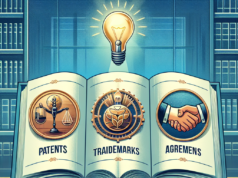
In an increasingly interconnected world, the significance of intellectual property (IP) has surged, becoming a cornerstone for innovation and creativity across various industries. However, as the value of ideas and inventions escalates, so too do the conflicts surrounding them. This article delves into the hidden battles of intellectual property disputes, exploring their implications for businesses, consumers, and the global marketplace.
Understanding Intellectual Property: A Foundation for Innovation and Creativity
Intellectual property encompasses a range of legal rights that protect creations of the mind, including inventions, literary and artistic works, designs, symbols, names, and images used in commerce. These rights are essential for fostering an environment where creativity and innovation can thrive, as they provide creators with the exclusive rights to their work, incentivizing investment in new ideas. By safeguarding intellectual property, societies encourage the development of new technologies, artistic expressions, and brands, ultimately contributing to economic growth and cultural enrichment. However, the complexity of IP laws and the varying regulations across jurisdictions can create challenges for individuals and businesses alike.
The Rise of Intellectual Property Disputes in the Global Marketplace
As globalization accelerates, the rise of intellectual property disputes has become a pressing issue for businesses operating in the international arena. The proliferation of digital technologies and the ease of information sharing have made it increasingly difficult to protect intellectual property rights. Companies often find themselves embroiled in legal battles over patent infringements, copyright violations, and trademark disputes, which can arise from both intentional and unintentional actions. The stakes are high, as these disputes can lead to significant financial losses, damage to reputation, and even the stifling of innovation. As a result, understanding the landscape of IP disputes is crucial for businesses seeking to navigate the complexities of the global marketplace.
Key Players in Intellectual Property Battles: Who’s Involved and Why
The landscape of intellectual property disputes involves a diverse array of stakeholders, including individual creators, small businesses, large corporations, and legal entities. Creators and inventors often seek to protect their innovations from infringement, while businesses may engage in aggressive litigation to defend their market position or to challenge competitors. Additionally, legal firms specializing in intellectual property law play a critical role in advising clients and representing them in disputes. Governments and regulatory bodies also influence the dynamics of IP battles through the establishment of laws and enforcement mechanisms. Understanding the motivations and strategies of these key players is essential for comprehending the broader implications of intellectual property disputes.
Common Types of Intellectual Property Disputes: An Overview of Legal Conflicts
Intellectual property disputes can manifest in various forms, each with its own legal complexities. Patent disputes often arise when one party claims that another has infringed upon their patented invention, leading to lengthy and costly litigation. Copyright disputes typically involve the unauthorized use of creative works, such as music, literature, or software, and can result in significant penalties for infringement. Trademark disputes, on the other hand, focus on the unauthorized use of brand identifiers, which can confuse consumers and dilute brand value. Additionally, trade secret disputes involve the misappropriation of confidential business information. Each type of dispute presents unique challenges and requires tailored legal strategies for resolution.
The Impact of Intellectual Property Disputes on Businesses and Consumers
The ramifications of intellectual property disputes extend beyond the courtroom, affecting businesses and consumers alike. For companies, prolonged legal battles can drain financial resources, divert attention from core operations, and hinder innovation. Small businesses, in particular, may struggle to survive the costs associated with defending their intellectual property rights. For consumers, these disputes can lead to reduced choices in the marketplace, as companies may withdraw products or services while legal issues are resolved. Furthermore, the uncertainty surrounding IP disputes can stifle competition, ultimately impacting prices and availability of goods and services. Thus, the consequences of intellectual property conflicts resonate throughout the economy.
Strategies for Resolving Intellectual Property Conflicts: Legal and Alternative Approaches
Resolving intellectual property disputes requires a multifaceted approach that can include both legal and alternative strategies. Traditional litigation remains a common method for addressing IP conflicts, but it can be time-consuming and expensive. As a result, many parties are turning to alternative dispute resolution (ADR) methods, such as mediation and arbitration, which can offer more efficient and cost-effective solutions. Additionally, proactive measures, such as conducting thorough IP audits, implementing robust compliance programs, and fostering open communication between parties, can help prevent disputes from arising in the first place. By employing a combination of these strategies, stakeholders can navigate the complexities of intellectual property conflicts more effectively.
The hidden battles of intellectual property disputes reveal a complex interplay of innovation, competition, and legal frameworks that shape the global marketplace. As businesses and creators continue to navigate these challenges, understanding the dynamics of IP disputes becomes increasingly vital. By fostering a culture of respect for intellectual property rights and exploring effective resolution strategies, stakeholders can contribute to a more equitable and innovative economic landscape. The ongoing evolution of intellectual property law will undoubtedly play a crucial role in shaping the future of creativity and commerce in our interconnected world.


























